Light and Its Properties

Abstract light pattern (teekid, iStockphoto)

Abstract light pattern (teekid, iStockphoto)
How does this align with my curriculum?
Learn about light and its properties.
Introduction
Light is all around us - even when it seems dark! Reflections in rear-view mirrors of cars help to keep us safe. Refraction through lenses of eyeglasses or contact lens’ helps some people see better.
Light part of the electromagnetic spectrum. The radio waves that let us listen to music are on this spectrum as are the infrared waves that let us communicate with our TVs.
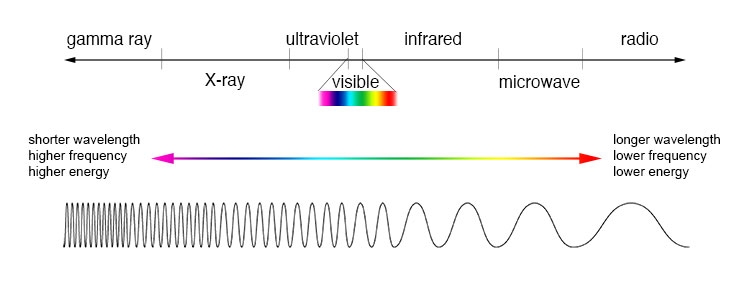
Image - Text Version
Shown is a colour illustration of the electromagnetic spectrum with wavelength, frequency and energy.
Three parallel horizontal scales illustrate aspects of the spectrum.
The first, on top, is a black line divided by thin vertical ticks. There are arrows at both ends, one pointing left and one right. Starting on the left, The first section is labelled "gamma ray." The next is "X-ray." Third is "ultraviolet."
The central section of the spectrum is the smallest. It is labelled "visible." This section is enlarged below the scale to show the colours of visible light. This section goes from white on the left, through magenta, violet, blue, cyan, green, yellow and red.
To the right, the next section is labelled "infrared." Then "microwave," then "radio," on the right.
The second scale is a long line illustrated in the same colours as the visible light spectrum, with arrows at each end. The left end of the line, near the arrow pointing left, is labelled "shorter wavelength, higher frequency, higher energy." The right end of the line, near the arrow pointing right, is labelled "longer wavelength, lower frequency, lower energy."
The third scale, at the bottom of the illustration, is a black line that curves up and down, over and over again. On the left, the curves are very close together, like zigzags. They get wider, gradually, as the line moves to the right side of the image. At the right end of the line, the last curve is wide and gentle, like a rolling hill.
This backgrounder is all about visible light and how we interact with it.
Speed of Light
In a vacuum, visible light travels at the speed of approximately 299 792 458 metres per second (m/s). This is known as the speed of light. It is the fastest that anything in the universe is able to move! For comparison, the speed of sound is only approximately 300 m/s. This is why during a storm you always see lightning before hearing thunder.
Did you know?
It only takes 8 minutes and 17 seconds for light to travel from the Sun to the Earth.
Waves of Light
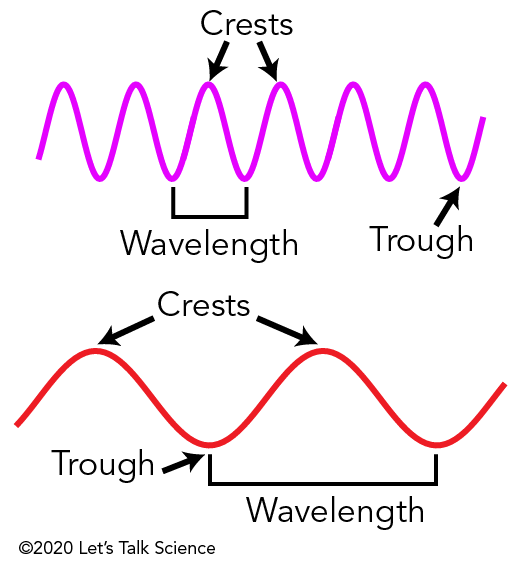
Image - Text Version
Shown are colour diagrams illustrating the difference in wavelengths between violet and red light.
The top diagram is a violet line that curves up and down, over and over, across the image. The curves are quite sharp. The peaks of the curves are labelled "Crests." The valleys are labelled "Trough." The length between two troughs is marked with a square bracket labelled "Wavelength."
The bottom diagram is a red, curving line. The curves here are wider and gentler than the violet line. Again, the crests and troughs are labelled. The length between two troughs is marked with a much wider bracket, labelled "Wavelength." This shows that the wavelength of red light is at least twice as long as violet light.
These different colours of light have different wavelengths and frequencies. Red light has the longest wavelength, and the lowest frequency of the visible spectrum. Violet has the shortest wavelength, and the highest frequency of the visible spectrum.
Colours of Light
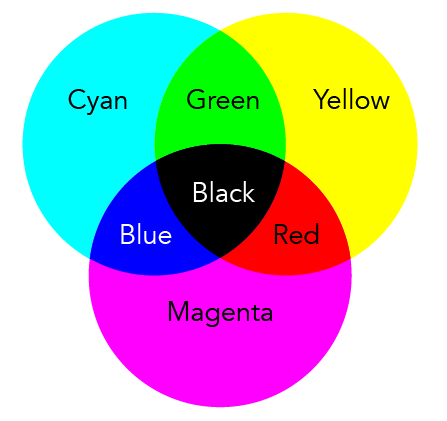
Image - Text Version
Shown is a colour diagram illustrating how primary colours of pigment are mixed to create secondary colours.
Three different coloured circles are arranged in a triangle shape on a white background. They overlap in the centre of the illustration. Each circle is labelled, as is each overlapping section.
Starting on the top left, the first circle is cyan. The top right is yellow. The bottom is magenta.
The area where cyan and yellow overlap is green. The area where yellow and magenta overlap is red. The area where magenta and cyan overlap is blue. The centre, where all three circles overlap, is black.
Mixing coloured materials, such as paint, is an example of subtractive colour mixing. Red paint appears red to us because when white light strikes it, the red pigments reflect the red wavelengths of light and absorb all of the wavelengths. This reflected light is what is seen by our eyes. The same is true for all of the other colours. So what about black? Black absorbs all of the colours of light and does not reflect any colours. We perceive this lack of light as black!
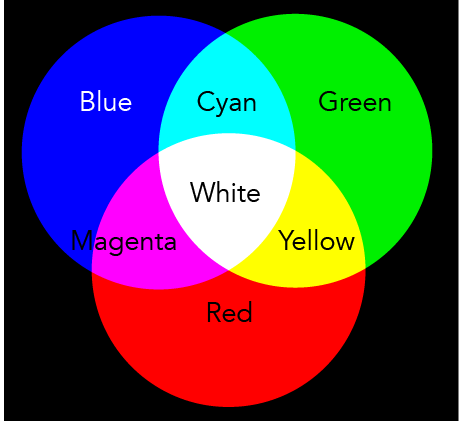
Image - Text Version
Shown is a colour diagram illustrating how primary colours of light mix to create secondary colours.
Three different coloured circles are arranged in a triangle shape on a black background. They overlap in the centre of the illustration. Each circle is labelled, as is each overlapping section.
Starting on the top left, the first circle is blue. The top right is green. The bottom is red.
The area where blue and green overlap is cyan. The area where green and red overlap is yellow. The area where red and blue overlap is magenta. The centre, where all three circles overlap, is white.
Mixing colours of light is an example of additive colour mixing. Red appears red to us because right wavelengths of light are sent towards our eyes. The same is true for all of the other colours. White is created by sending out all of the wavelength of light. So what about black? In additive colour mixing, black is the absence of light. In other words, no wavelength of light is sent out. We perceive this lack of light as black!
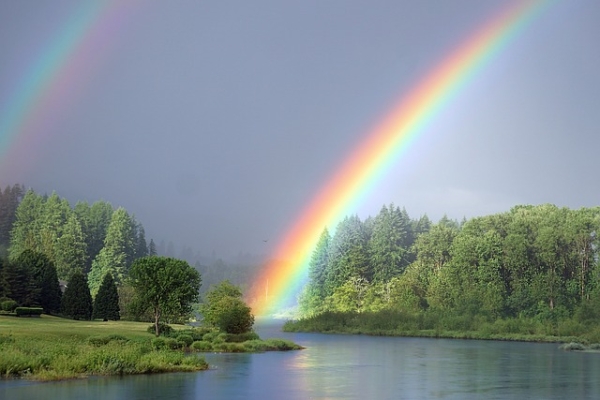
Image - Text Version
Shown is a colour photograph of a rainbow in the sky over a lake.
The rainbow is a bright stripe of light across dark grey sky. It contains narrow parallel stripes of red, orange, yellow, green, blue, indigo and violet. The bottom of the rainbow is at the top of the lake in the lower middle part of the image. It stretches up over the trees to the top right corner. Another faint rainbow can be seen some distance to the right of the first.
The colours of the rainbow are reflected in the smooth, greyish blue water in the foreground. The lake is surrounded by green grass, shrubs and trees that fade into mist behind the rainbow.
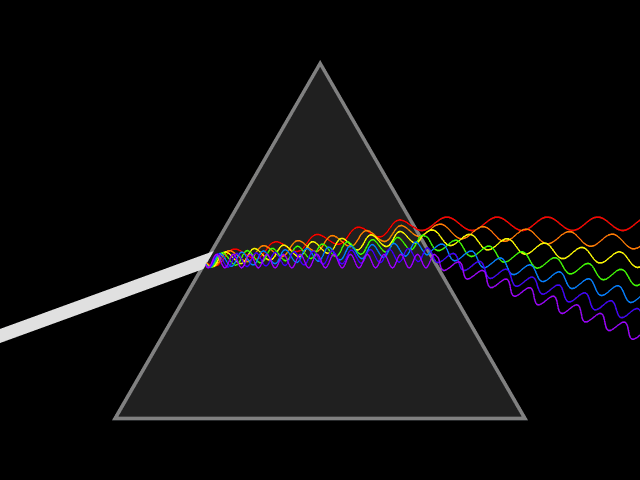
Waves of light being split by a prism (Source: Lucas Vieira [public domain] via Wikimedia Commons).
Image - Text Verision
Shown is a colour animated GIF of light splitting into separate colours by travelling through a prism.
The prism is a large dark grey triangle on a black background, outlined in white. The light starts as a thick white stripe. It comes in from the lower left and hits the edge of the prism at an angle.
Inside the prism, the light is shown as seven overlapping, wavy, coloured lines constantly moving from left to right. The lines are dense tangle on the left inside the prism. They are further apart, but still touching at the right edge.
Outside the prism, on the right, the lines become separate. Starting from the top, they are: red, orange, yellow, green, blue, indigo and violet. The red line has the longest waves. The waves in each coloured line get shorter and shorter. The violet line has the shortest waves.
Check out this backgrounder for more about how we see colour and different types of colour blindness.
How Light Travels
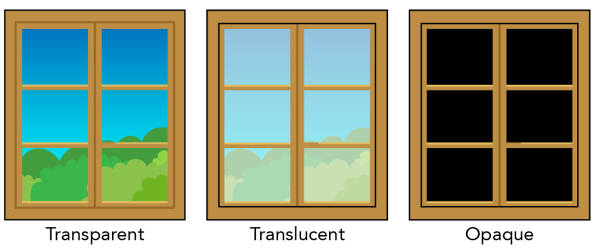
Image - Text Version
Shown is a colour illustration of the same view through windows made of transparent, translucent and opaque glass.
Starting on the left, the first window is labelled "Transparent." The view through this is clear. Green, leafy trees can be seen in the lower part of the window, and the sky above is bright blue.
The second window is labelled "Translucent." The view through this looks foggy or misty. The trees and sky are faded colours.
The third window is labelled "Opaque." The view through this is completely black. No trees, sky, or any colours can be seen.
Each window has the same wooden frame with six panes of glass. All three are labelled underneath in black letters.
To Summarise
- Light travels very fast - at the speed of light in fact!
- Light travels as waves.
- Light travels in straight lines.
Learn More
Is Light a Particle or a Wave? - Colm Kelleher (2013)
This video by TED-Ed (4:23 min.) explores how scientists understand how light works - where it comes from, how we see it and how it behaves.
Wave Behaviour (2018)
This video by Fuse School (4:14 min.) demonstrates how waves behave when they encounter different materials. These behaviours include transmission, reflection, refraction, diffraction, absorption and scattering.
Tour of the Electromagnetic Spectrum 01 - Introduction (2010)
This video by NASA (5:03 min.) gives an overview of the electromagnetic spectrum and the ways we use it every day.
References
BBC Bitesize Science. (n.d.). Electromagnetic waves.
Laws, J. M. (2017). Reinventing the Wheel: Why Red is not a primary color. John Muir Laws.
NASA BestofScience. (2010). The electromagnetic spectrum.
NASA Godard Space Flight Centre. (2013). Electromagnetic spectrum.
Panagiotakopoulos, G. (2012). Experiments on refraction, reflection and total internal reflection. [Video] YouTube.
University of Toronto. (n.d.). Reflection and refraction.